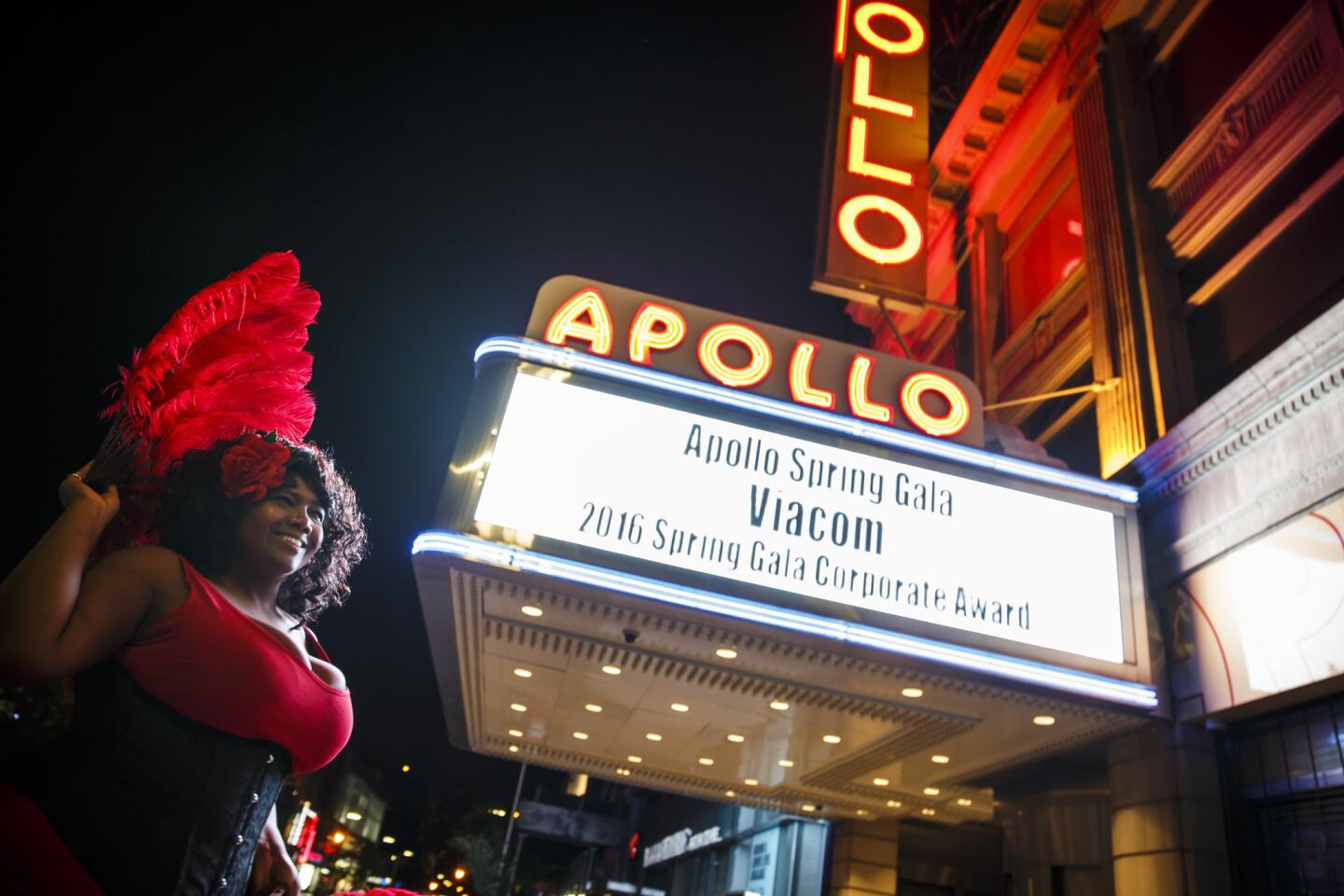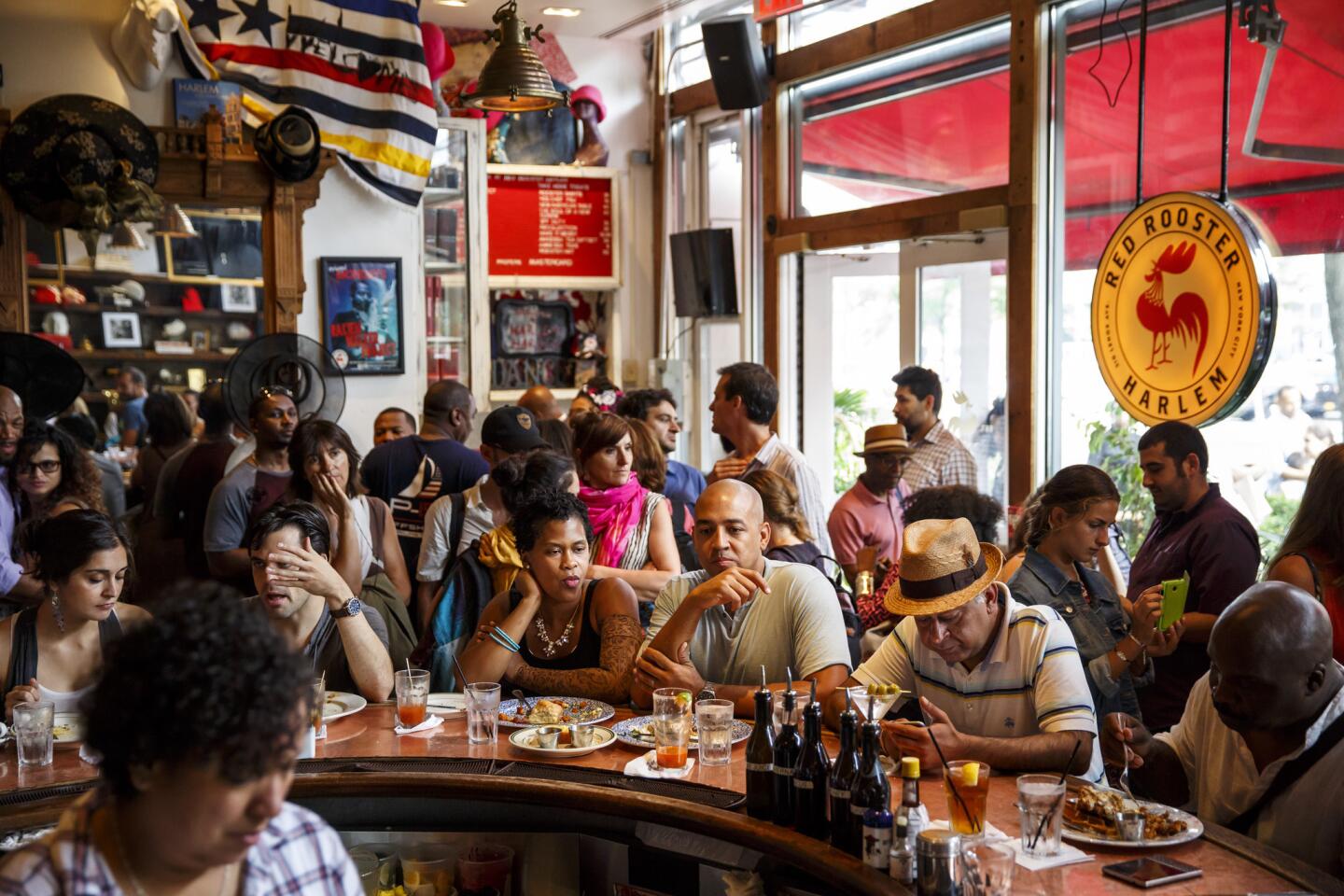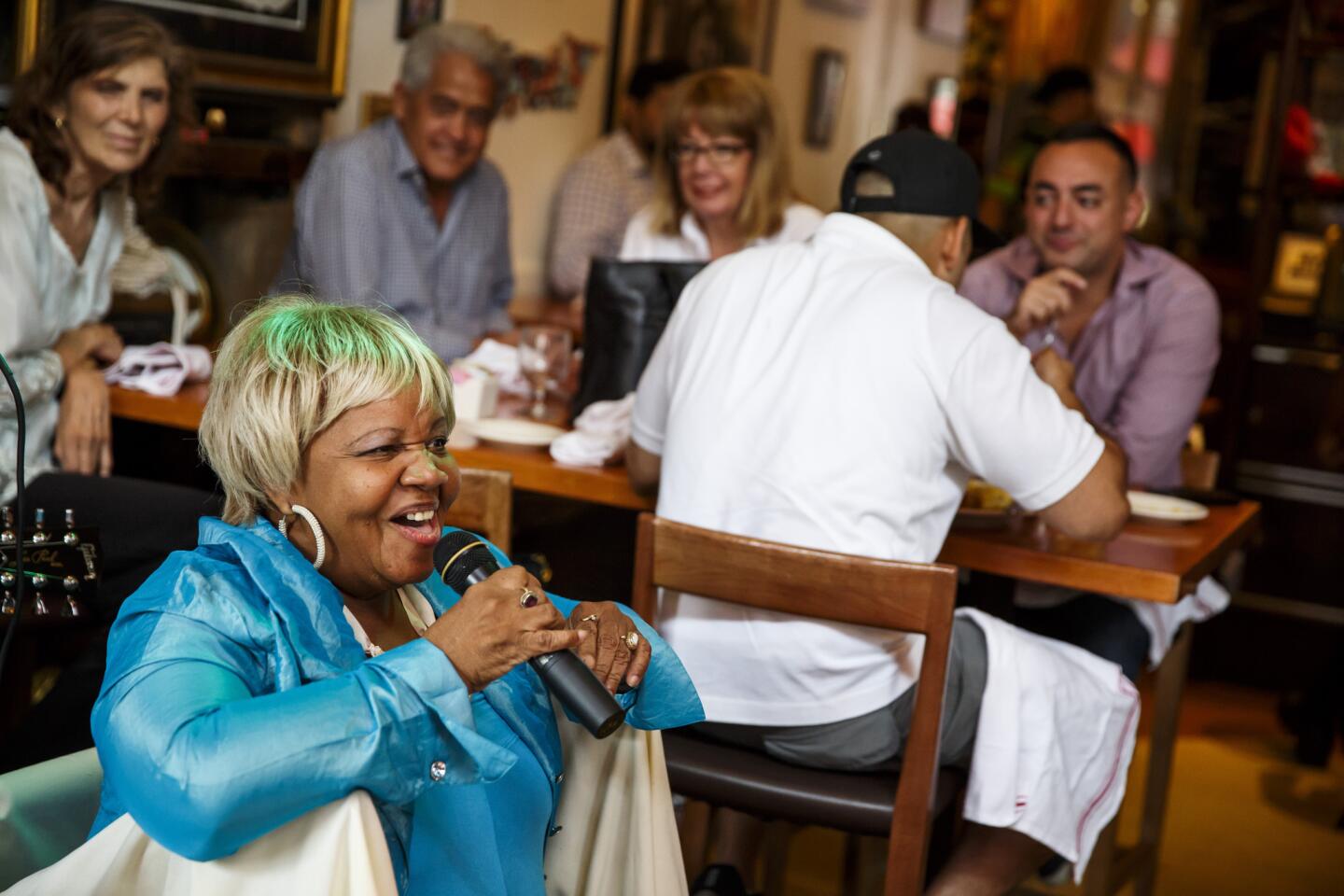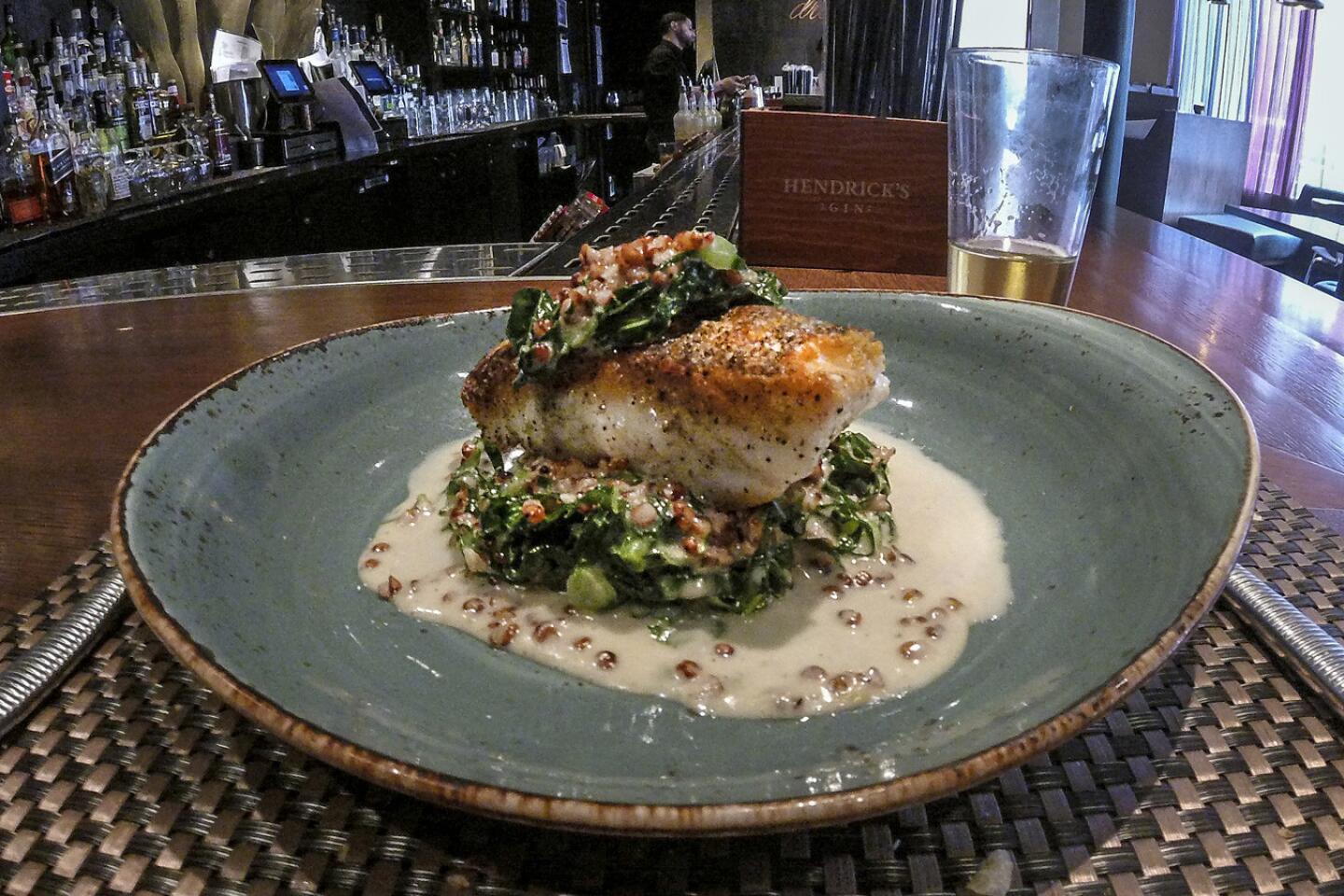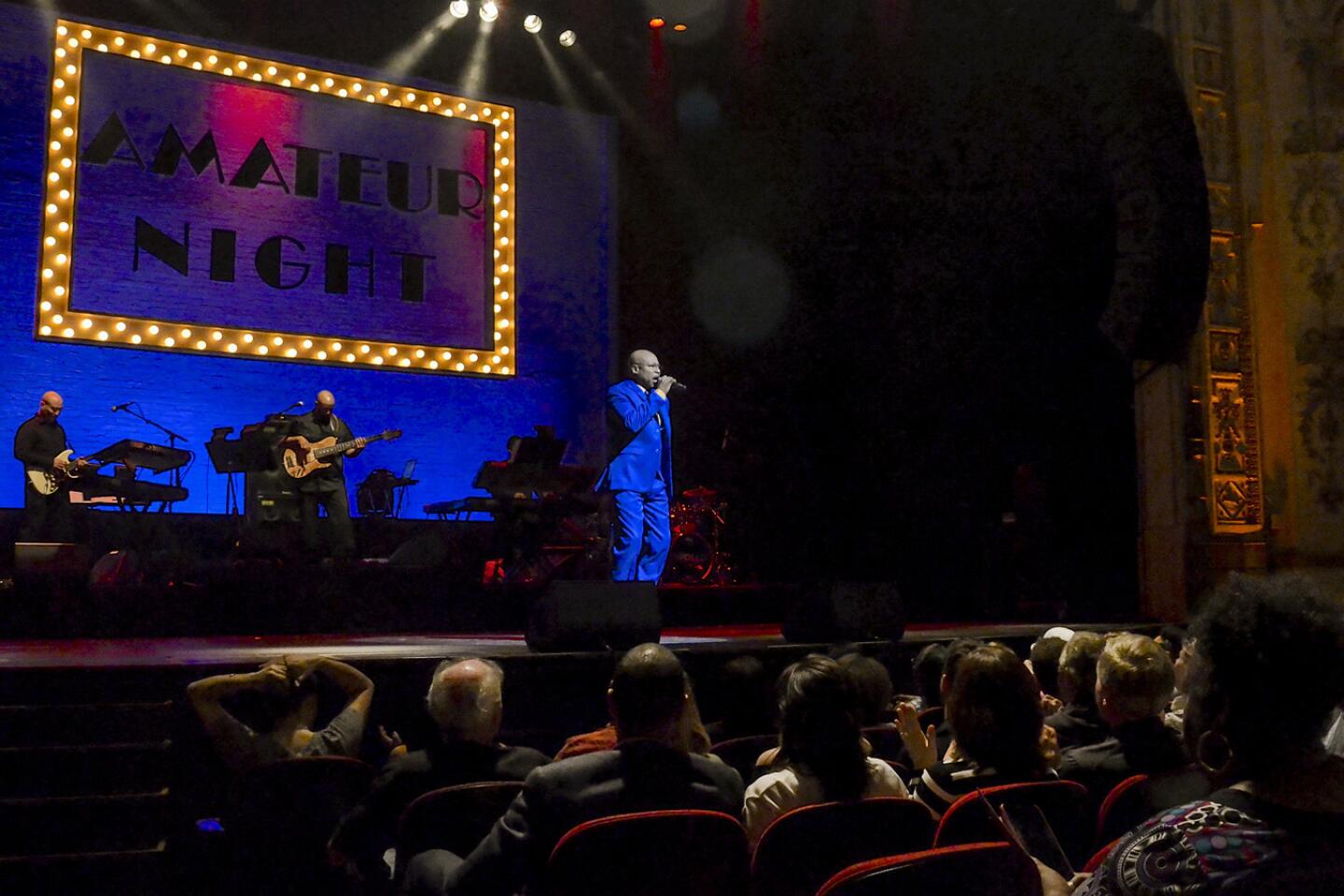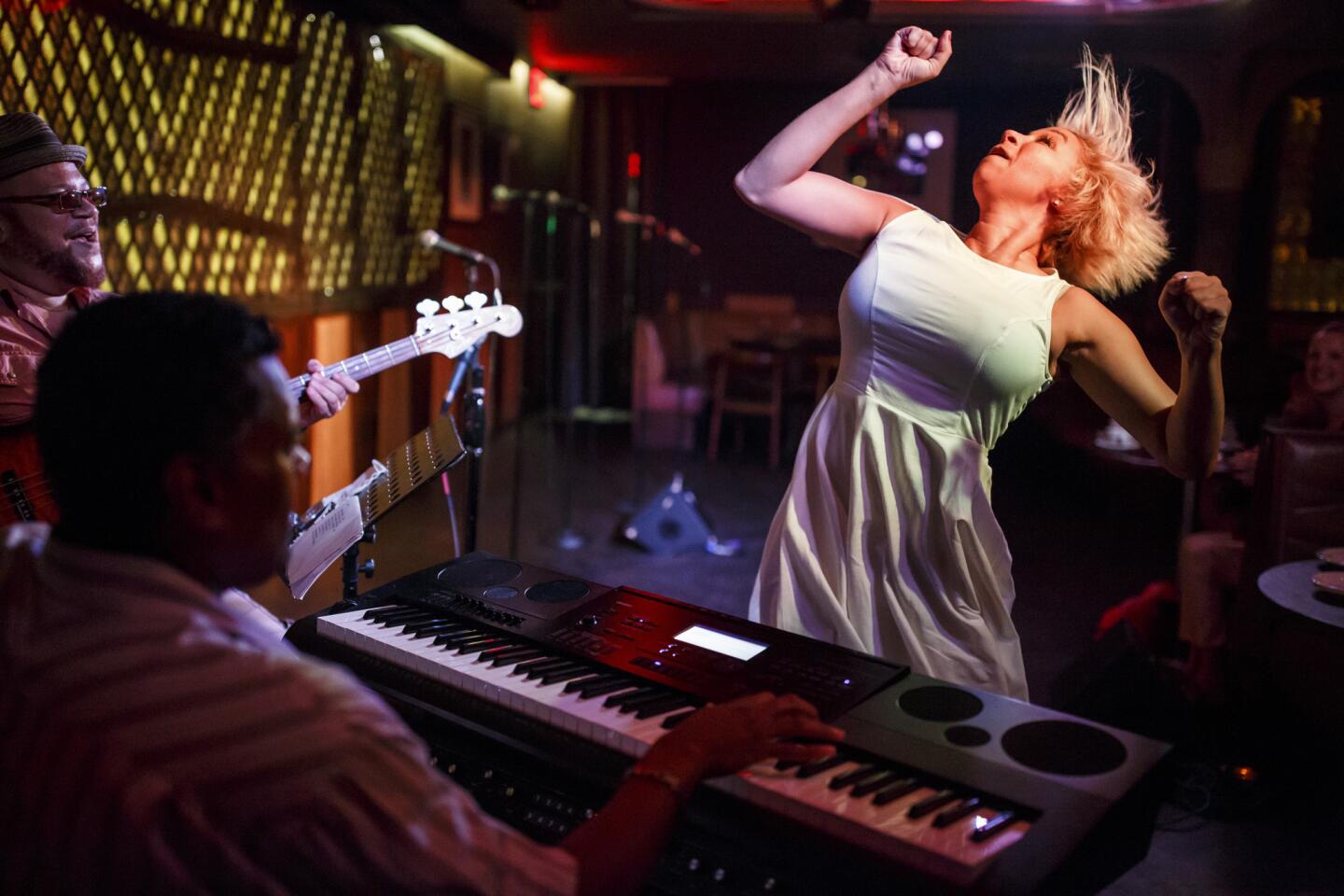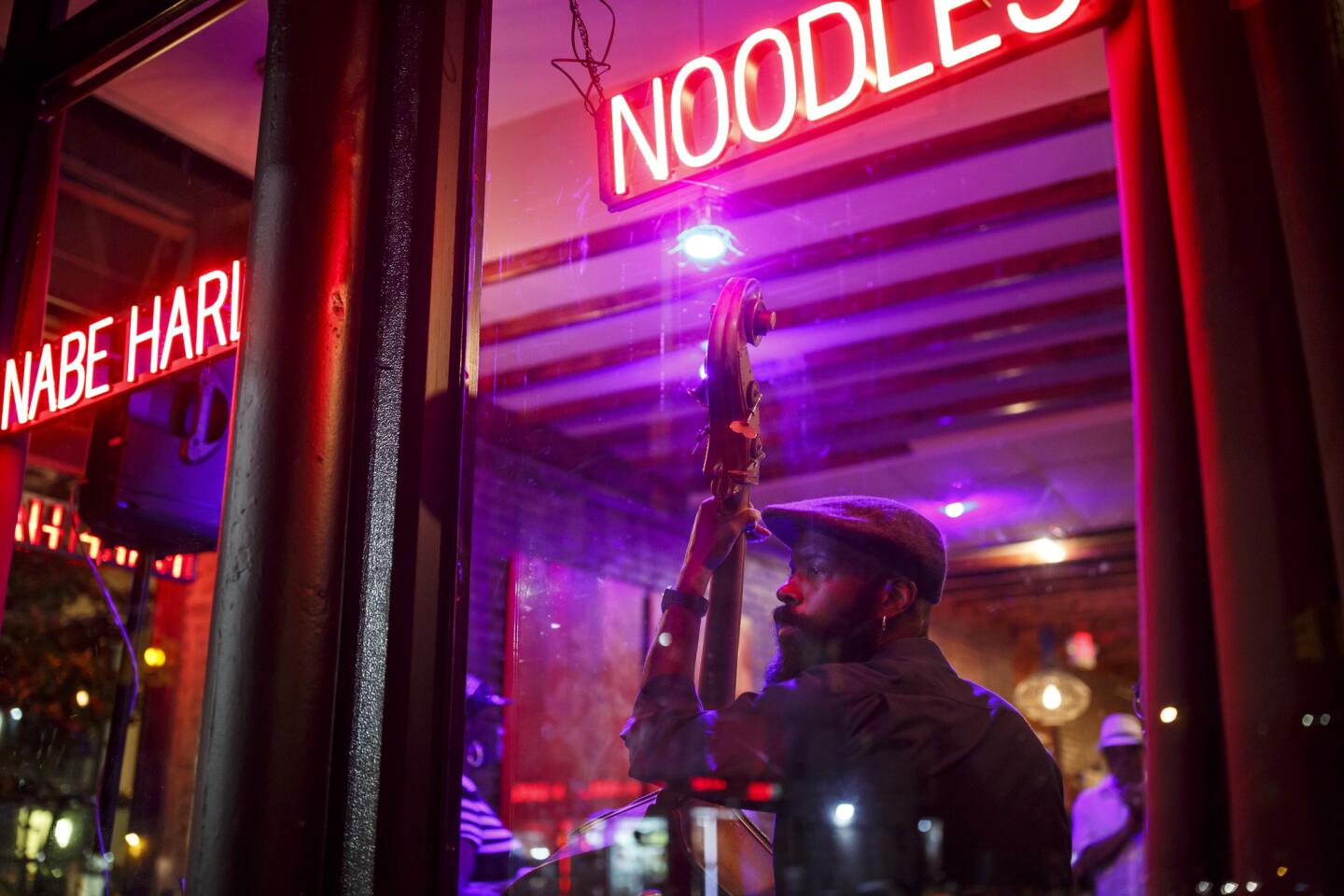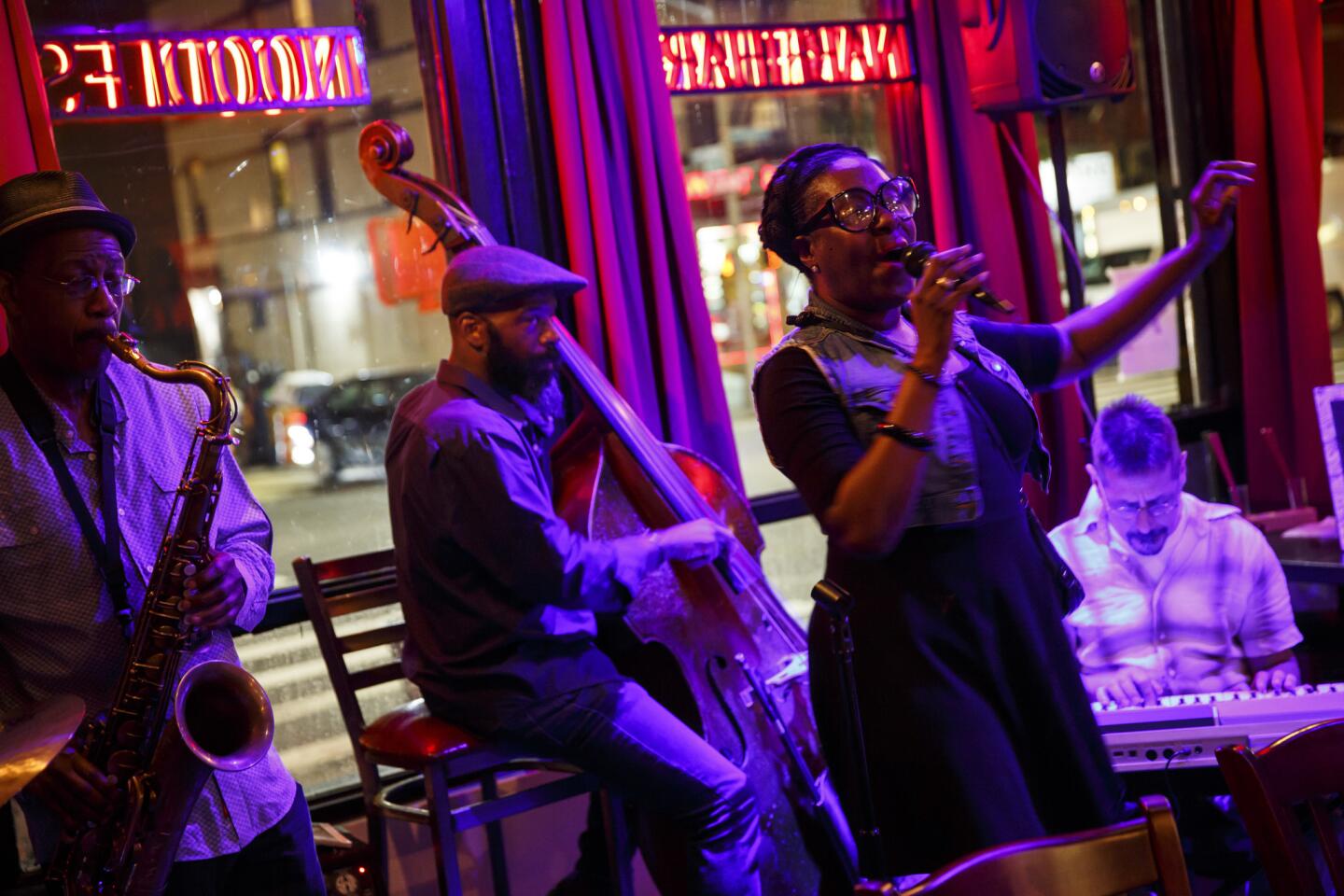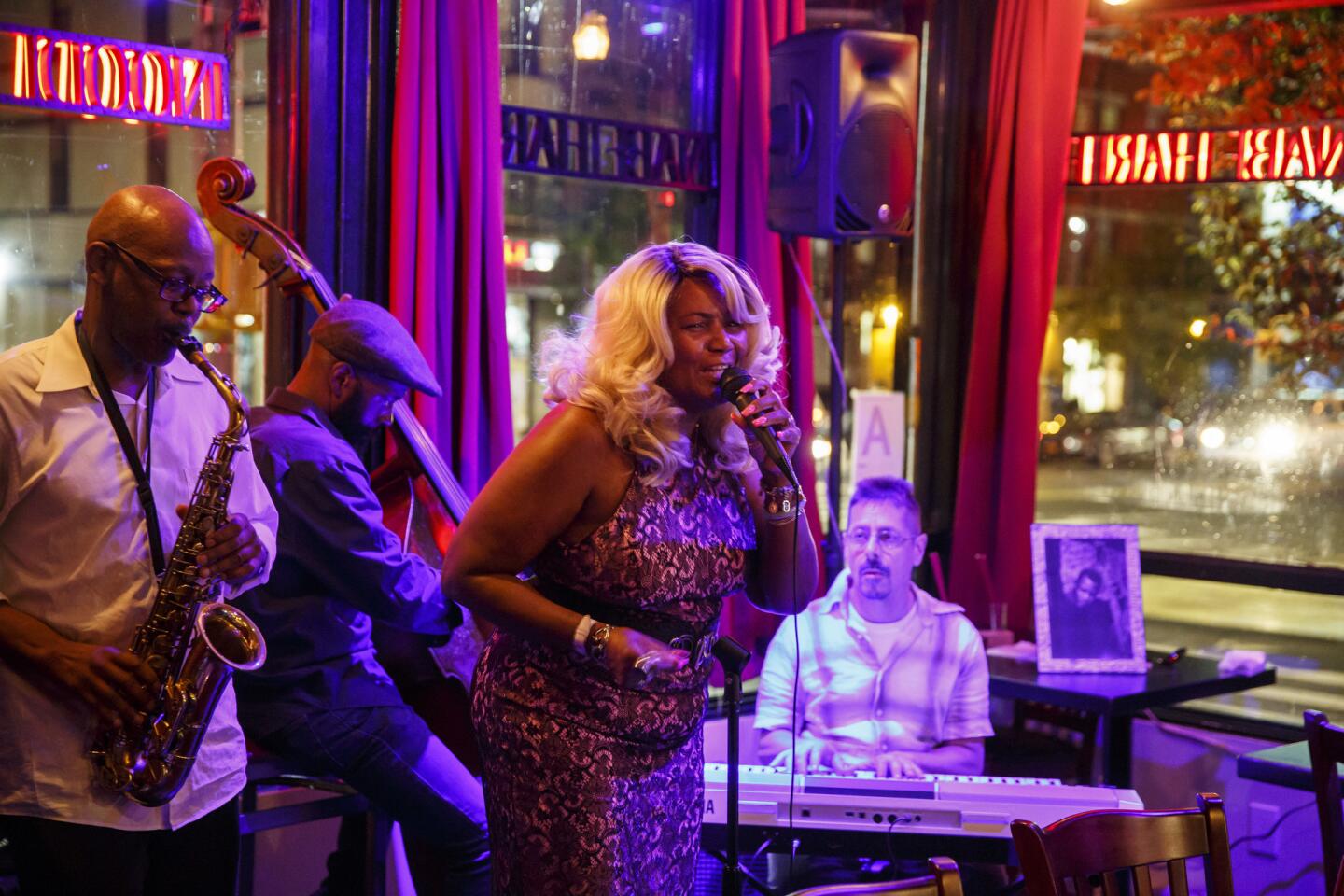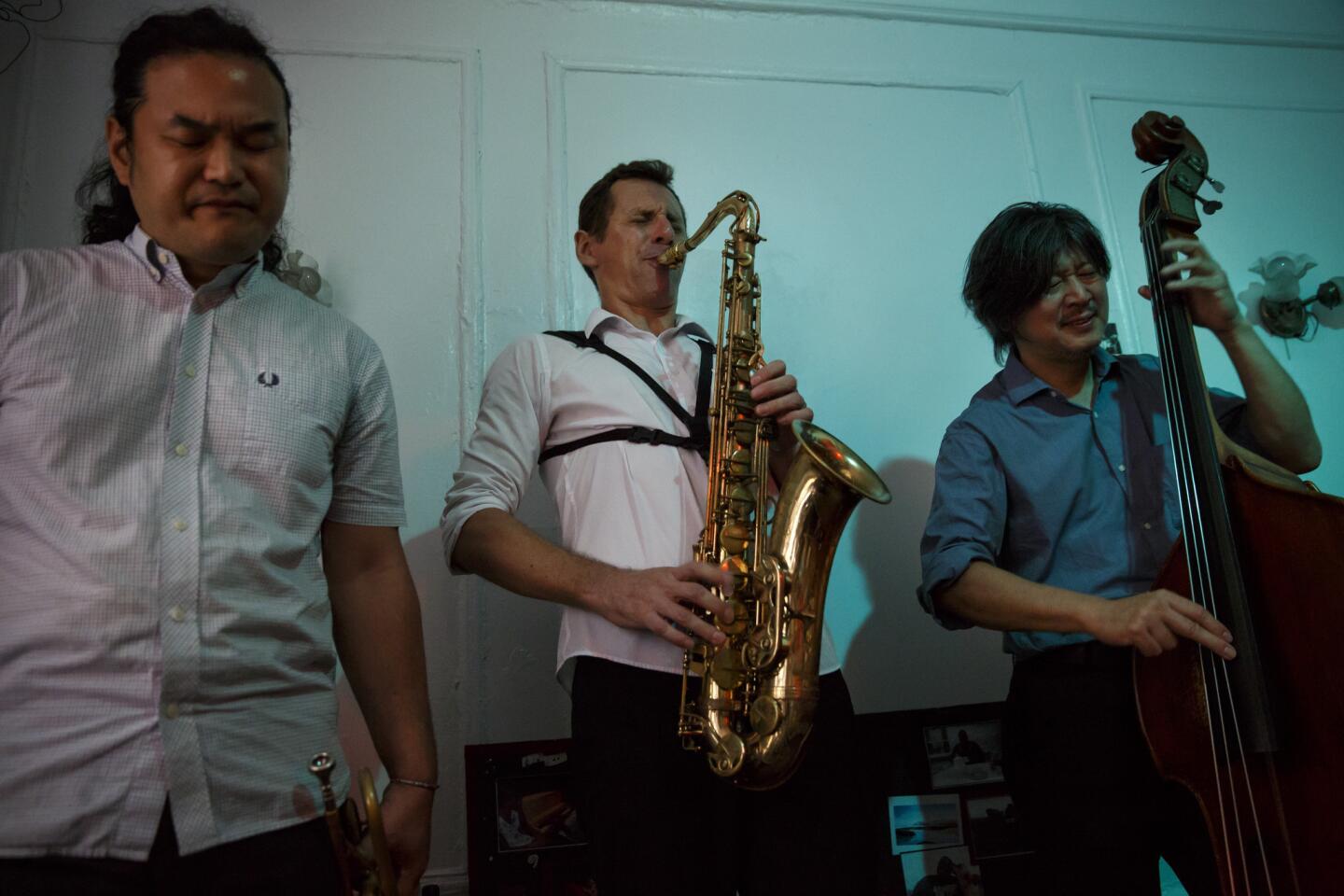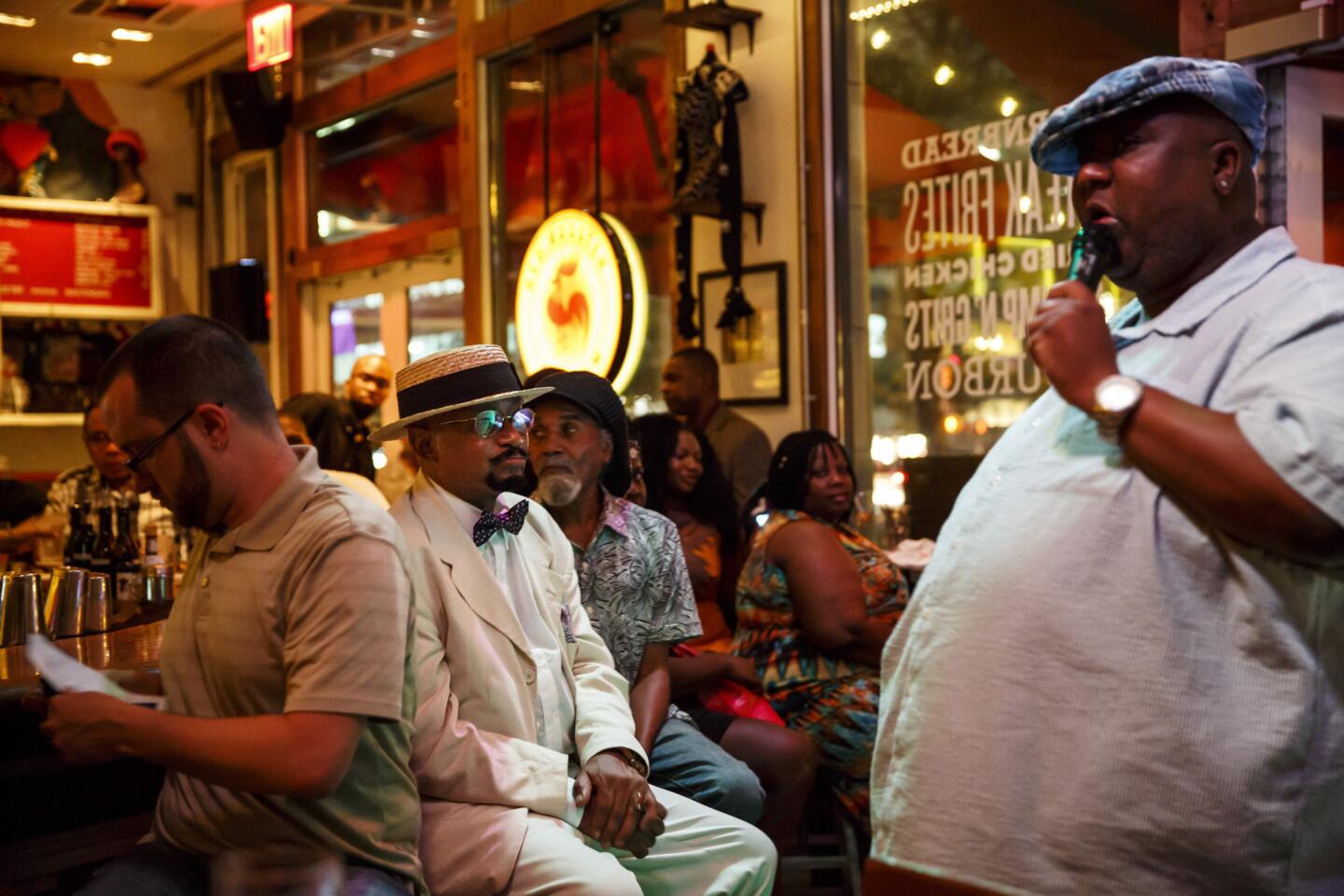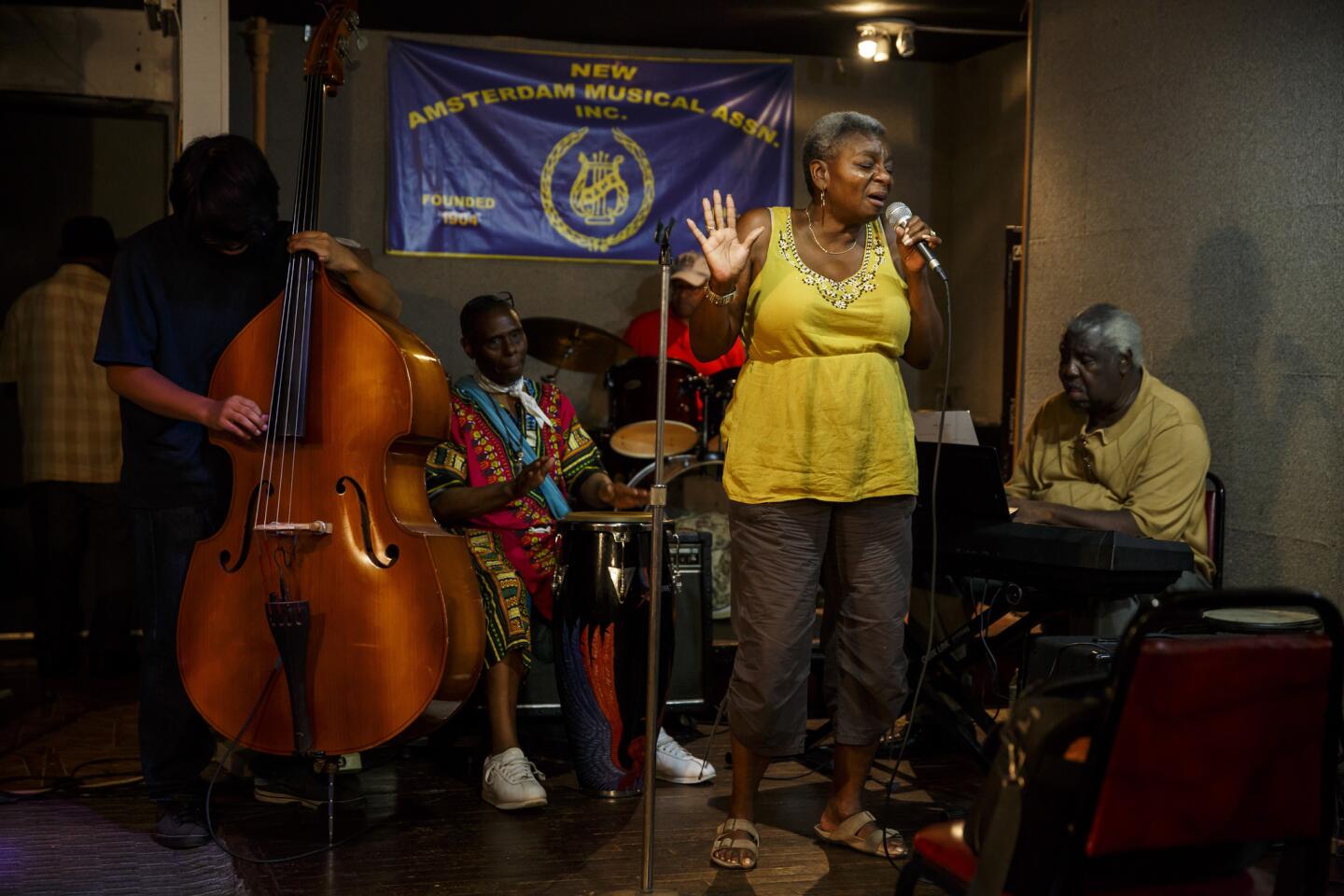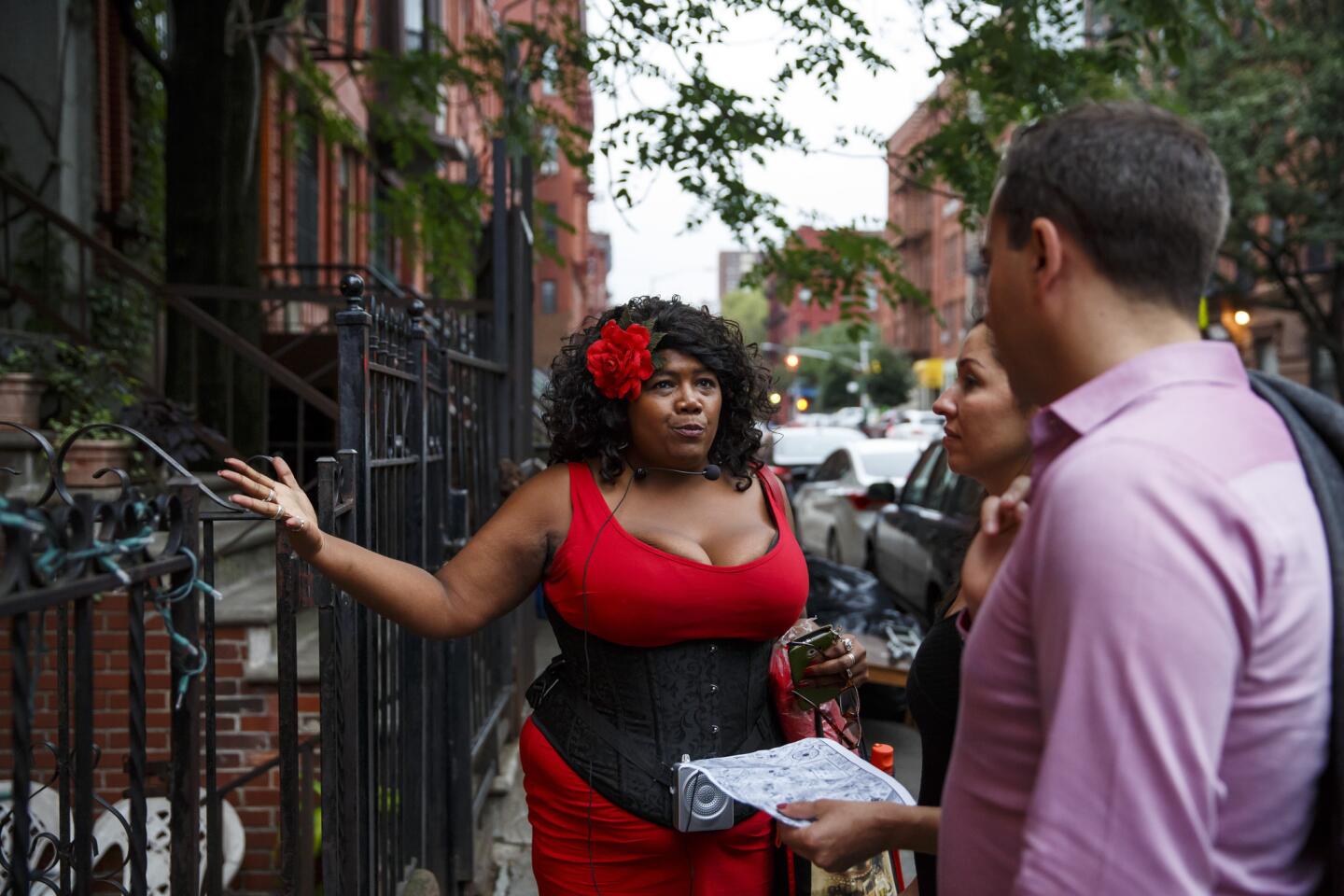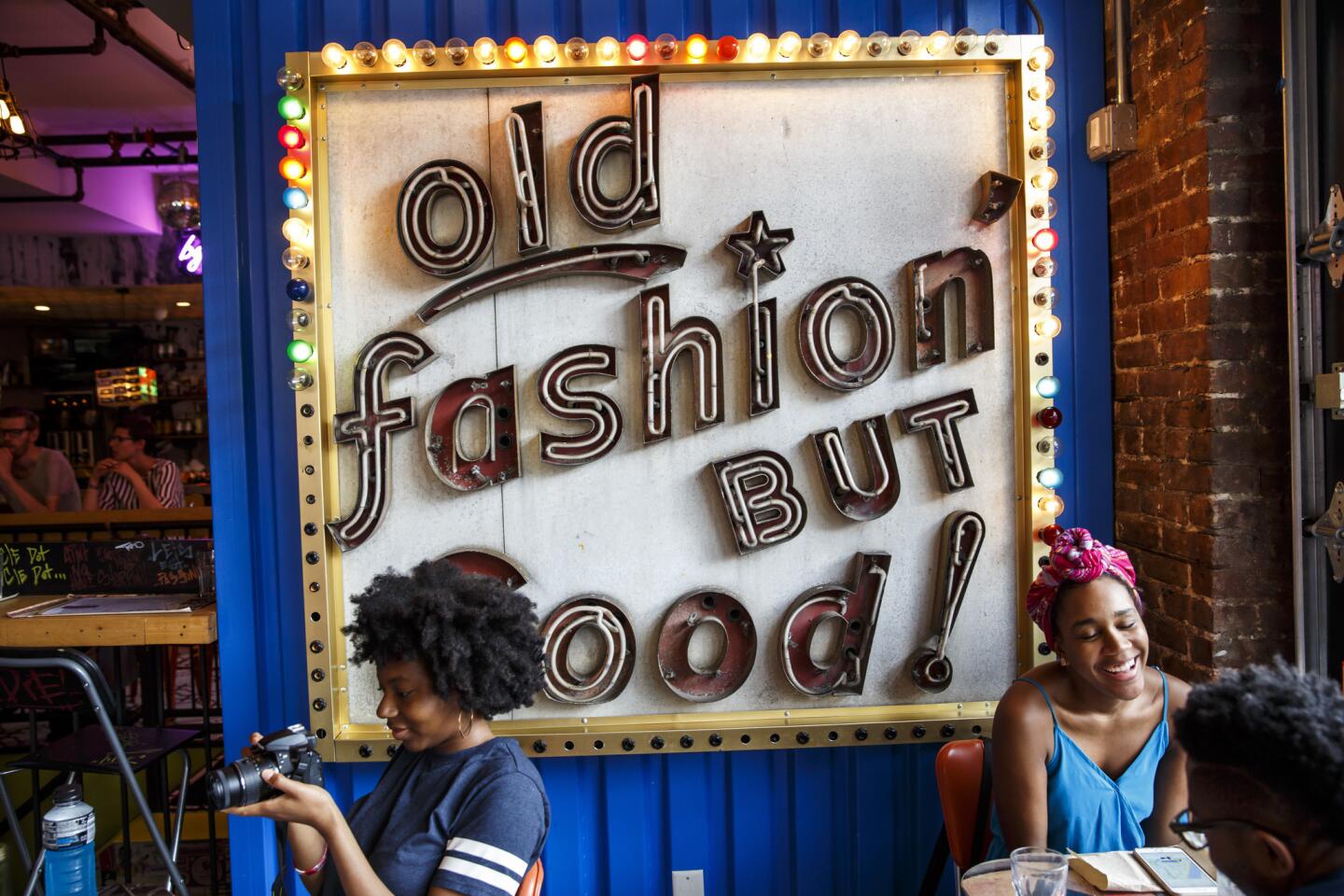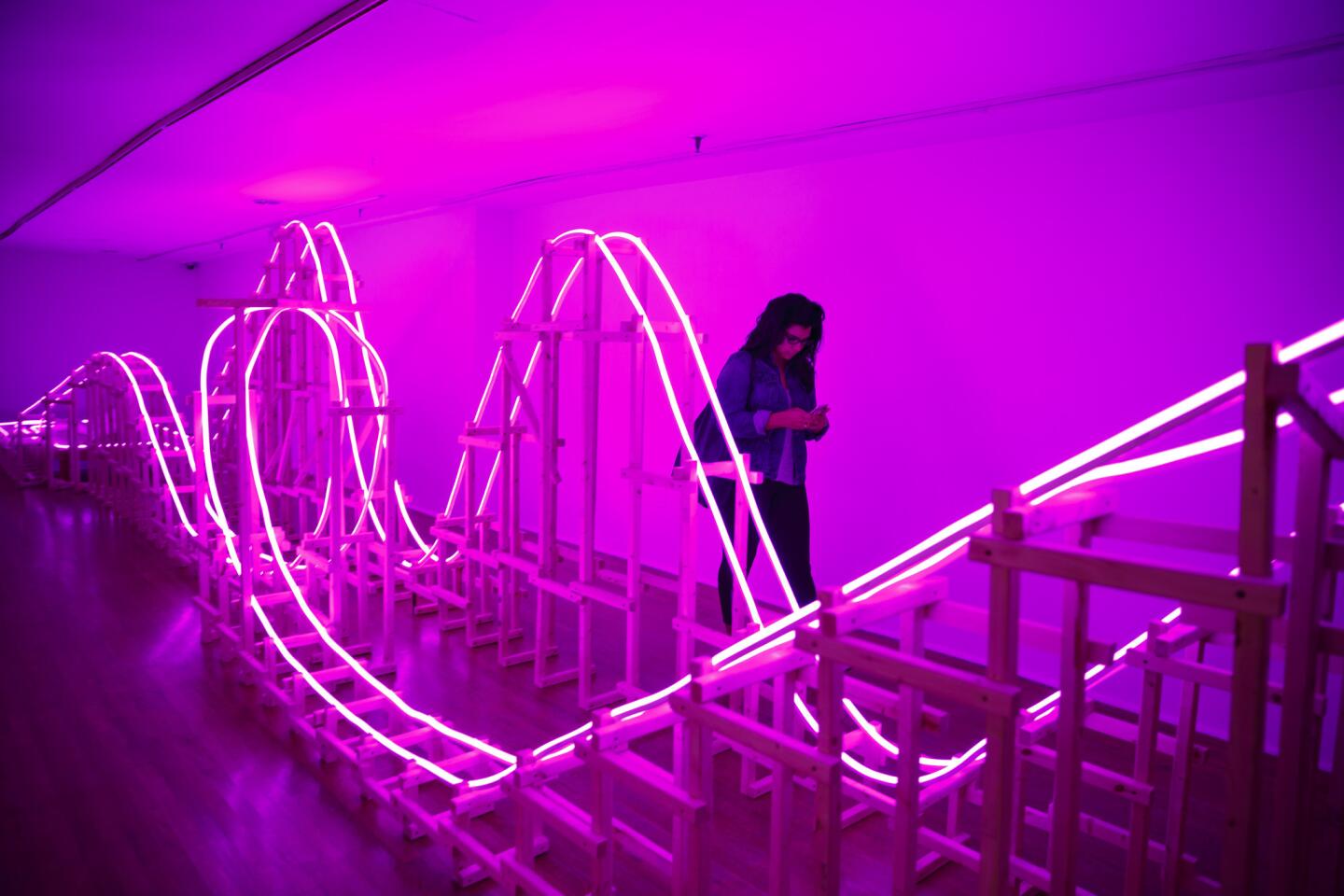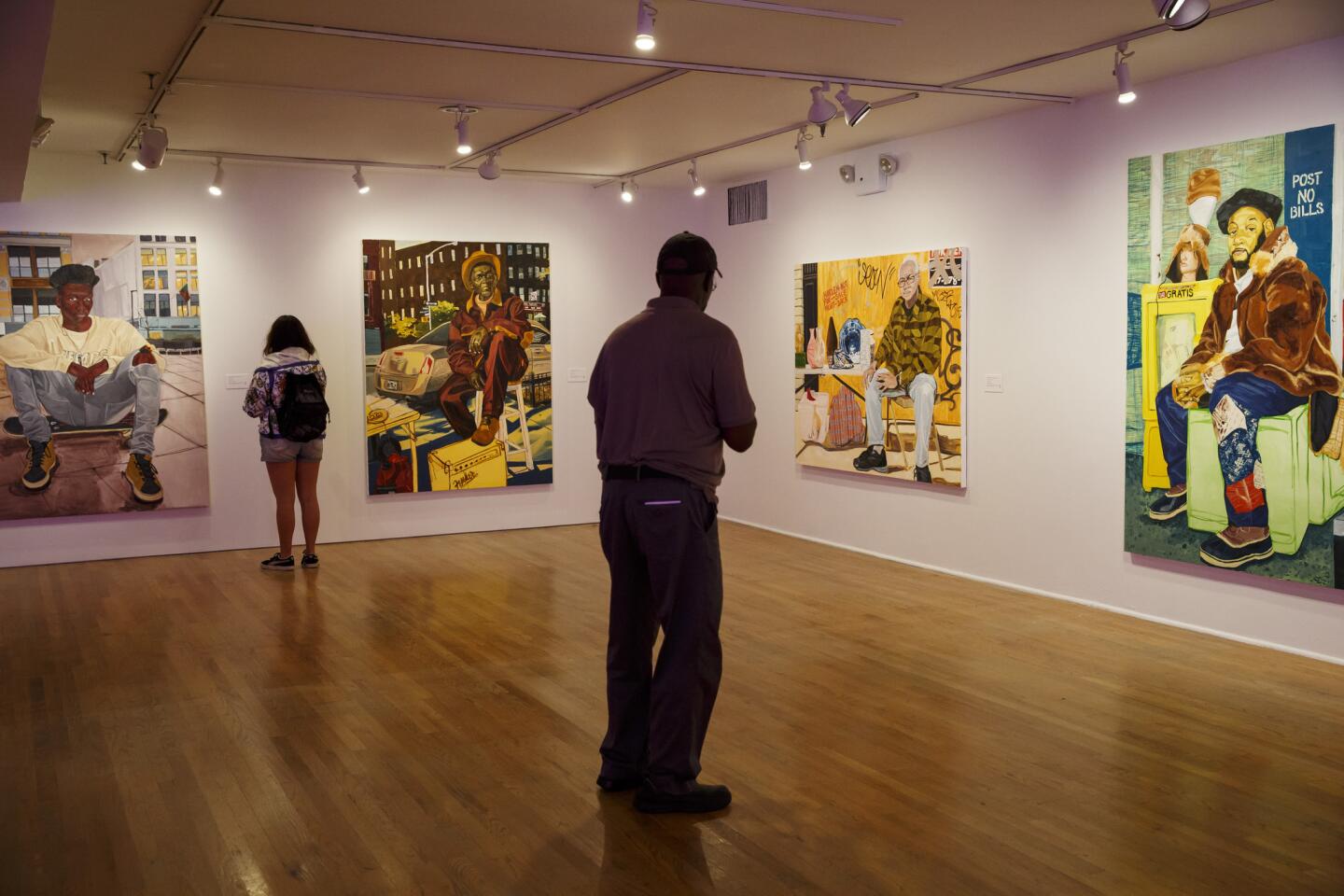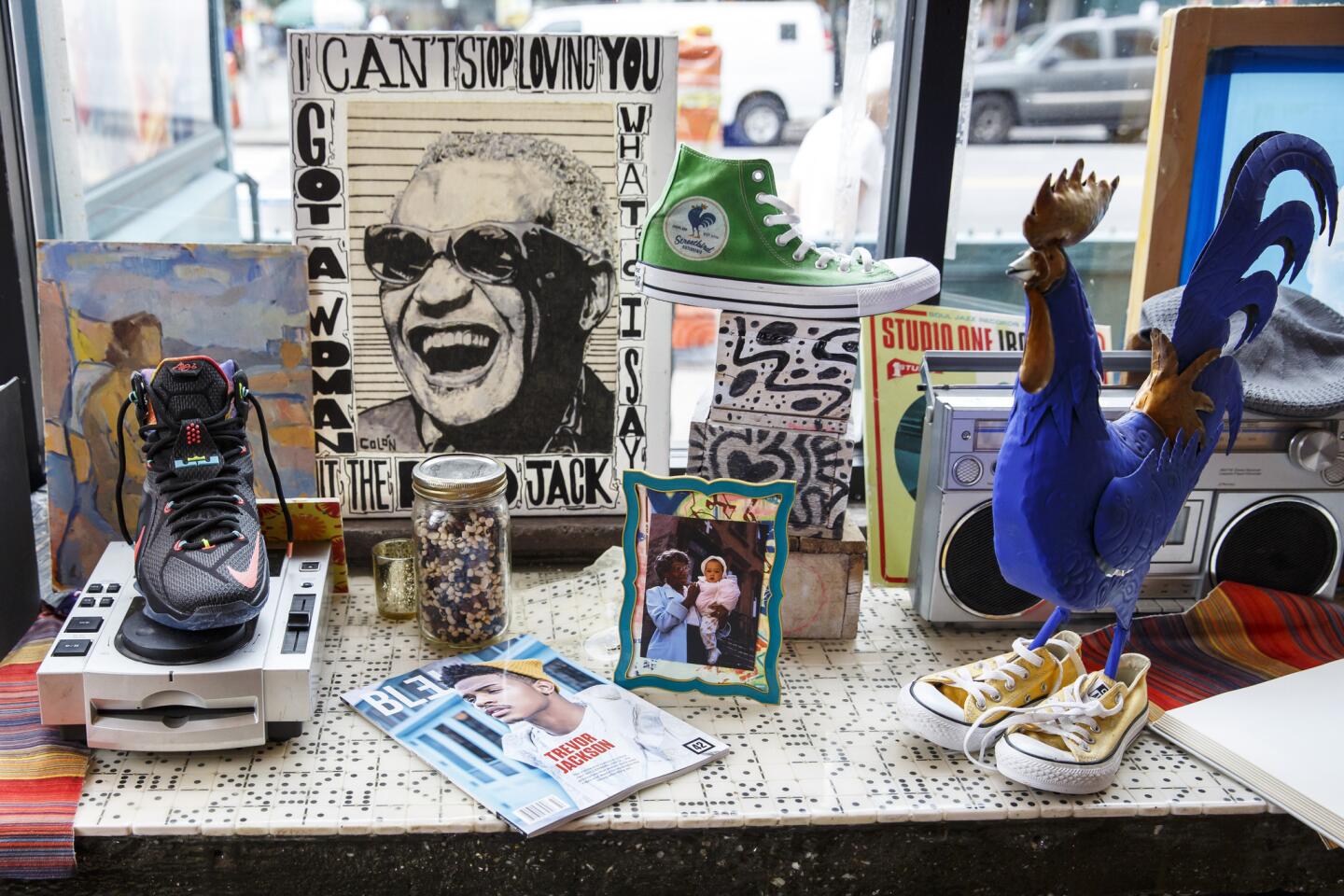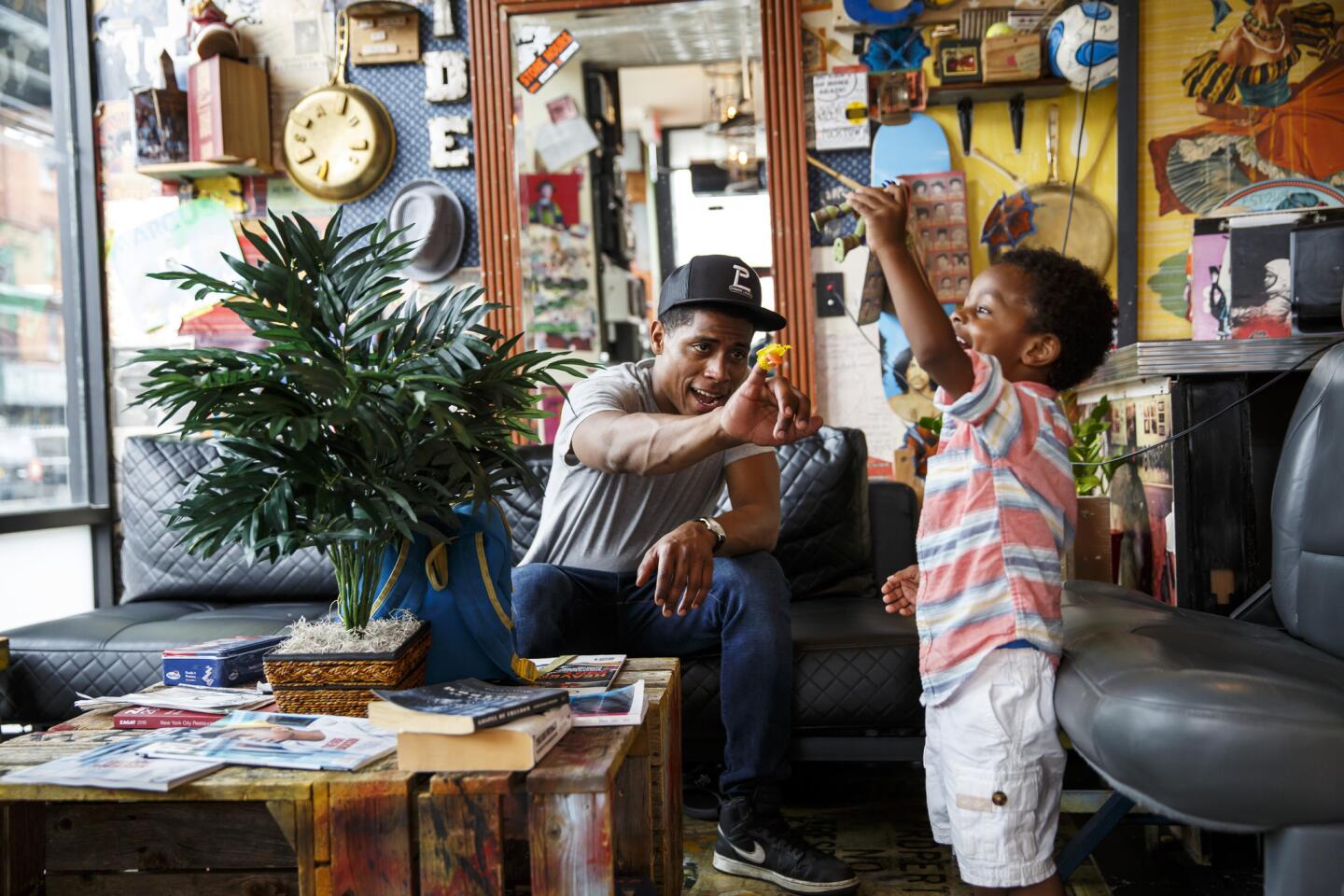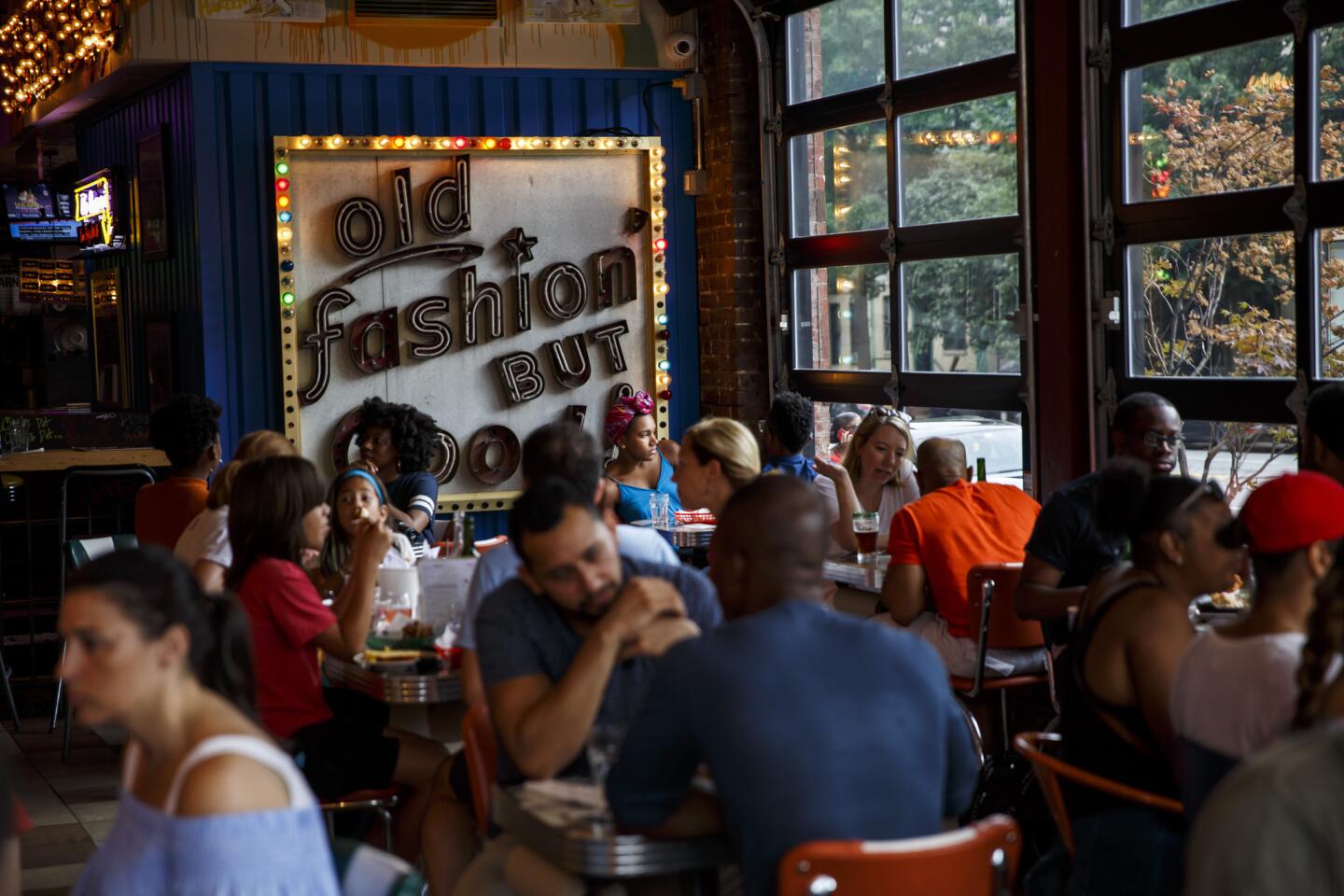A newcomer takes on Harlem, where a second renaissance meets gentrification nervousness

This video covers my rookie night in Harlem, and it was a big one: sidewalk drummers, amateur night at the Apollo, one retro speakeasy and one swinging jazz dive.
- Share via
Reporting from New York — Take a walk on 125th Street. Check out the Apollo Theater marquee, the latest exhibit at the Studio Museum, the patio dinner crowd on Lenox Avenue, the high-priced brownstones, the locals of all hues striding past Afrocentric sidewalk stalls while a drum circle grooves across the street.
Harlem, several years into a burst of new prosperity, is rolling like an Uptown train with a full head of steam.
Even the Starbucks harbors surprises. On the afternoon I ducked in, model Nia Fields, preparing for a photo shoot, had just put on the headgear of a neo-Egyptian queen. The results were so dramatic, I thought some customers might drop their drinks and start building her a pyramid.
See the most-read stories in Life & Style this hour >>
“We’re doing a modernized Nefertiti,” said Melanie Gonzalez, her Nikon-bearing friend and director.
New projects, new diversity, new buzz and creeping anxiety — this is what a first-time tourist finds in Harlem. And the newcomers don’t come any newer than me.
I’ve been to Manhattan many times. But it was only in May, after several years of reading about Harlem’s multiplying restaurants, falling crime rate and rising rents, that I made my first journey on foot above 110th Street.
I set aside a day and a night. I booked a room at the Aloft Hotel, which, when it opened in 2010 at Frederick Douglass Boulevard and West 124th Street, became Harlem’s first new hotel in more than 40 years.
Most of my itinerary was new attractions. I was visiting midweek, so there would be no gospel brunches or Sunday church-music tours.
First up was a Crispy Bird sandwich for lunch at Red Rooster Harlem, where the menu is dressed-up comfort food, the service is courtly and the diners come in all ages and shades.
Then came a lively stroll on 125th Street, where I encountered jazz bassist and vocalist Esperanza Spalding doing a sound check for an outdoor show. I should have realized then that this was going to be a good-luck trip.
For dinner: the Cecil, a trendy minimalist dining room on West 118th Street known for its Asian-African fusion cuisine. I had the pan-roasted cod with sorghum and coconut collard greens.
Then it was time for entertainment.
I started with Amateur Night at the Apollo, a Wednesday tradition of many decades that has evolved into a show mostly for tourists. There’s a DJ, a house band, a comedian host, a video tribute to remind you that Ella Fitzgerald got her start here in 1934, a kid segment (no booing allowed), a diverse roster of amateurs and plenty of audience participation, including a tap-dancing “executioner” who leads adult performers offstage when the boos get too intense.
Yes, I booed a few acts. The amateur comedian all but demanded it, and the Apollo credo, after all, is “be good or be gone.” But the two-hour show was kinder, gentler and kid-friendlier than I had expected, not unlike a night of cruise ship entertainment.
For a seventh-row orchestra seat I paid $33 — pocket change, compared with Broadway prices.
And that was good, because after the Apollo, I still had a jazz diva to meet and two bars to hit.
The diva was Amanda Humes, an aspiring singer, Harlem resident and guide for Big Apple Jazz Tours. We met atop the steps to Gin Fizz Harlem, a throwback speakeasy above the well-regarded French bistro Chez Lucienne.
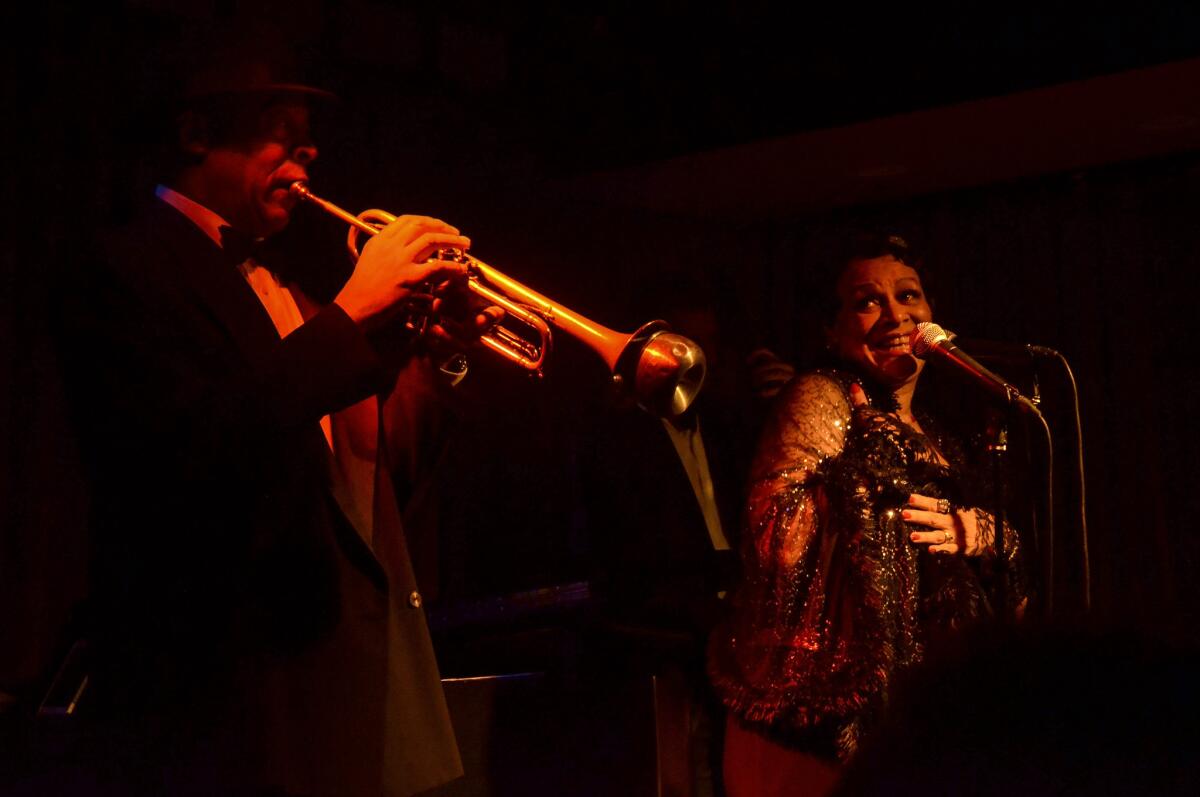
The upstairs room’s tin ceilings and velvet banquettes set a nice ’20s tone, ideal for the evening’s program, a revue in previews called “Black Pearls & White Diamonds in Harlem.”
There was tap-dancing. Torch songs. Sassy duets. Unfortunately, it was a packed house with no discernible air-conditioning. At what temperature, I wondered, do black pearls and white diamonds melt?
But the well-seasoned troupe — many longtime Harlem performers in their 60s and beyond — clung to their boas and fedoras and clearly loved having their way with such standards as “Satin Doll,” “Mood Indigo” and “Darktown Strutters’ Ball.”
Next, Humes and I headed down Lenox Avenue toward the next joint. As we walked, she sneaked in some history.
For instance, those Stars of David on the façade of Mount Olivet Baptist Church. The building began life as a synagogue in 1907. In those days, Humes said, Harlem was mostly Jewish, German and Italian. Harry Houdini lived on West 113th Street; Milton Berle was born on West 118th. But that world was about to change.
Between 1910 and 1950, a wave of African American arrivals — and an undertow of European American departures — transformed the population of central Harlem from 10% black to 98%.
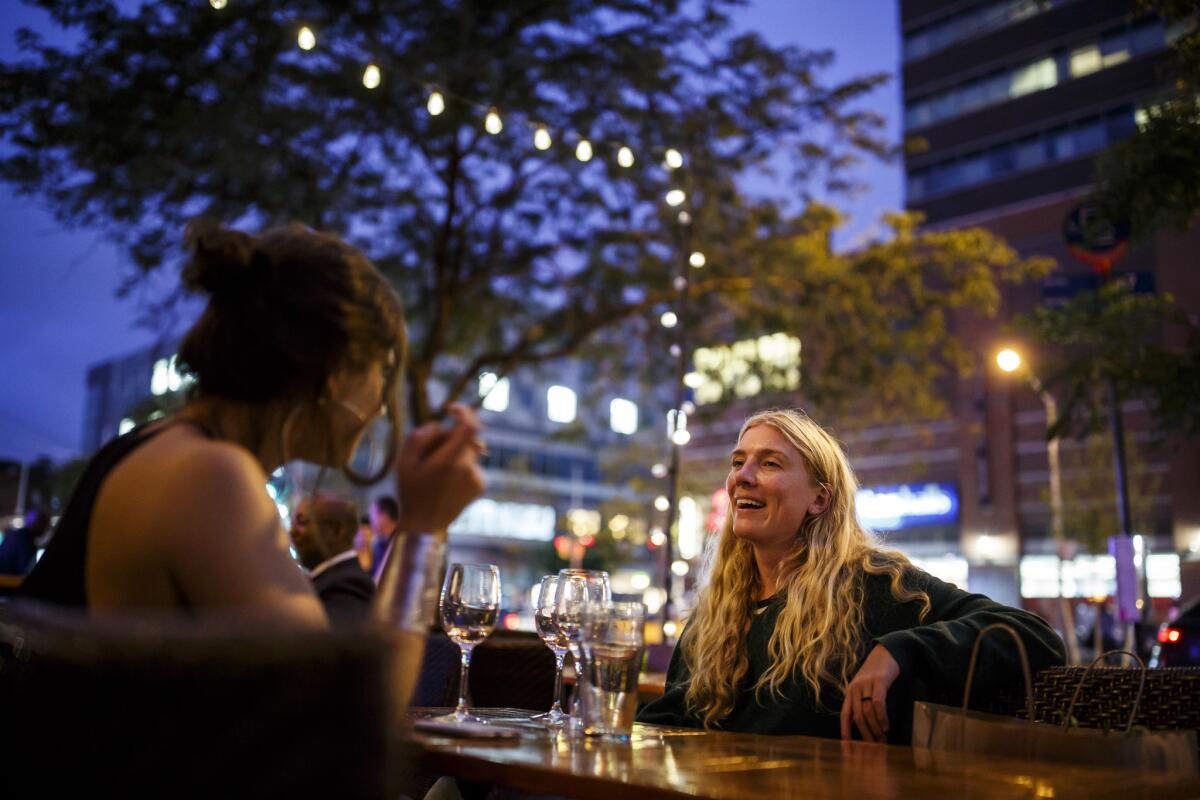
Along the way came the writers, musicians and artists of the Harlem Renaissance, followed by a long, deep decline that began to reverse about 25 years ago.
Now here’s a revised Harlem, awash in new money and new people. And that too is easy to see on the street. Just look, Humes said, at the restaurants that have opened since 2013 in the old brownstones on Lenox Avenue.
She pointed out Chaiwali, offering Indian fusion food and fancy teas near 124th Street, Chéri (French, near 122nd Street) and BLVD Bistro (soul food, at 122nd Street). We might have missed Barawine (wine bar and bistro near 120th Street), but you get the idea.
Remember hearing how taxi drivers wouldn’t go to Harlem?
These days, “we get yellow cabs, we get green cabs, we get black cars, we get Ubers, we get Lyft, and there are policemen everywhere. That did not used to be,” said Humes, who has lived in Harlem for about 20 years.
However, “there’s uncertainty that comes when you see new people coming into the neighborhood, people who don’t understand the holy ground they’re standing on.”
In fact, we had just passed one of the saddest Harlem stories of recent years, the Lenox Lounge.
There’s uncertainty that comes when you see new people coming into the neighborhood, people who don’t understand the holy ground they’re standing on.
— Amanda Humes
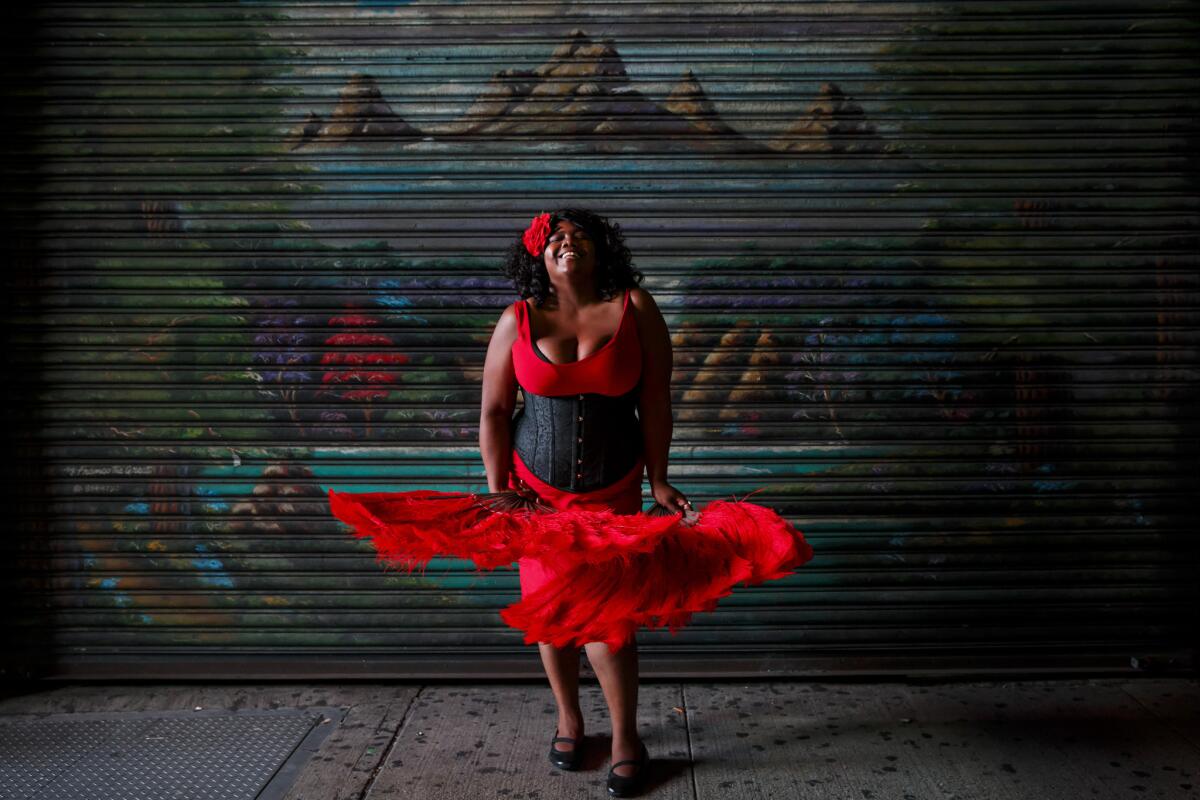
The lounge, opened in 1939, was an Art Deco landmark and a jazz mainstay for more than 70 years, a place where Dizzy Gillespie and John Coltrane played, James Baldwin and Langston Hughes drank and Billie Holiday had her own booth.
After a dispute between the club owner and the building’s owner in late 2012, the Lenox Lounge didn’t just go dark; its iconic sign, bright red paneling and furnishings were spirited away.
As we passed its impoverished facade, we could just make out the ghostly outlines on the sign where the letters used to be.
After that, it was a pleasure to arrive at the night’s last bar.
“Summertime, and the livin’ is easy,” sang Johnny Lovesong, flanking tenor sax man Les Goodson on the tiny stage of Paris Blues on 7th Avenue. There was room for about 50 people, many of them musicians waiting their chance to sit in. Wednesday is jam session night.
Humes pointed out owner Sam Hargress Jr., who opened the bar in 1969, bought the building and moved in upstairs. Forty-seven years later, with no rent hikes to worry about, Hargress has his own piece of Harlem’s new prosperity.
“Gentrification doesn’t bother me — it helps me,” he told me. But he’s not flaunting anything. Just about everything in the club looks as though it’s been here since 1969. Or earlier.
Gentrification doesn’t bother me — it helps me
— Sam Hargress Jr.
“You come in and you’re immediately at home,” Humes said.
“I went to Columbia, but this was my life university.”
On this night, a bunch of regulars had gathered to celebrate the birthday of Goodson, who leads the Wednesday night jams. The crowd was about half African American, half everybody else, not unlike the rest of central Harlem’s demographics these days.
The next morning, I tagged along with Neal Shoemaker of Harlem Heritage Tours. He was leading a mostly white group of students and teachers from Woodland Regional High School in Beacon Falls, Conn. Many were seeing Manhattan for the first time.
“Some of the kids are nervous,” American literature teacher Michele Papa told me. “That’s OK. It’s good to take them out of their comfort zone.”
The discomfort multiplied when a young black cyclist at Lenox Avenue and 136th Street yelled at us: “Hey, crackers! Get...out of here!”
Not everyone heard it, but Shoemaker was undaunted. First he shouted “Shut up!” as the cyclist disappeared into traffic, then he marched us to the site of the old Savoy Ballroom at 141st Street (now a housing complex), where a couple of older men from the neighborhood greeted the group.
Along the tree-shaded 1890s brownstones of Striver’s Row, the aristocratic blocks of West 138th and 139th streets where Eubie Blake, W.C. Handy, Fletcher Henderson and Bill “Bojangles” Robinson once lived, Shoemaker greeted another longtime local, who welcomed the teens to her neighborhood.
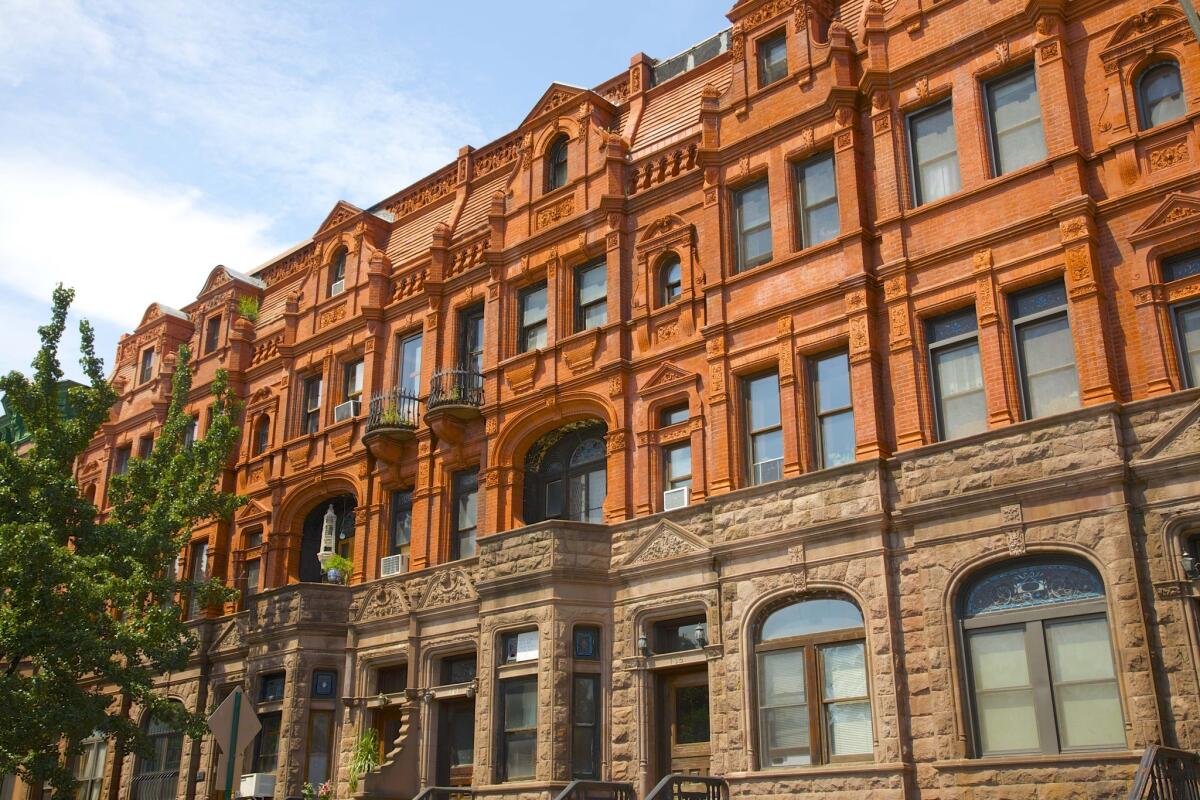
As we walked, Shoemaker pointed out the new businesses and the new residents. Crime “has dropped like you would never believe,” he said. But every time he hears of another million-dollar townhouse sale, he worries about how long his aunt will be able to pay $600 a month for her apartment near 138th Street.
I’ll think about that tension between community character and new money for a while. But I’ll also remember the way we closed down Paris Blues.
The room was full of people and birthday balloons. Jennifer Jade Ledesna stepped up to sing and scat “Caravan.” Humes offered “Honeysuckle Rose.” Young talents such as trombonist Corey Wilcox and sax player Erena Terakubo traded fierce solos with the veteran Goodson and a parade of others.
Then out came a cake and somebody lighted a sparkler. The players and listeners crowded into a big, loud circle: two trombones, two saxophones, a flute and a guitar, along with a pianist, a bassist and a drummer, swinging hard.
Harlem has challenges, but on that night in Manhattan, I’m not sure there was any place happier than that little club on West 121st Street.
Twitter: @mrcsreynolds
If you go
THE BEST WAY TO NEW YORK
From LAX, American, United, JetBlue, Virgin America and Delta offer nonstop service to New York, and Southwest, United, Virgin America, American, Delta and Frontier offer connecting service (change of planes). Restricted round-trip airfare from $480, including taxes and fees.
WHERE TO STAY
Aloft Harlem, 2296 Frederick Douglass Blvd. at 124th Street; (212) 749-4000 or (866) 716-8143, www.aloftharlem.com. Opened in December 2010 with 124 rooms. Rooms for two from about $255.
WHERE TO EAT
Red Rooster Harlem, 310 Lenox Ave. ; (212) 792-9001, www.redroosterharlem.com. Chef Marcus Samuelsson offers sophisticated comfort food for lunch and dinner. Main dishes $18-$39. Also on site: The Nook, a “pocket within Red Rooster” with sandwiches and snacks for less than $8, and Ginny’s Supper Club (which often has live jazz).
The Cecil, 210 W. 118th St.; (212) 866-1262, www.thececilharlem.com. Executive chef Joseph Johnson’s menu emphasizes the African diaspora, but it has plenty of Asian elements too. Dinner only, main dishes $18-$32.
Corner Social, 321 Lenox Ave.; (212) 510-8552, www.cornersocialnyc.com. Chef Elpidio Escamilla’s eclectic menu includes empanadas, grits and ravioli. Casual tavern setting. Main dishes $17-$39.
WHERE TO LISTEN
Apollo Theater, 253 W. 125th St.; (212) 531-5305, www.apollotheater.org and www.amateurnight.org. Programming varies widely (pop music, comedy, ballet and a jazz tribute to Michael Jackson are coming up), but Wednesday is always amateur night. Amateur night tickets usually $21-$33.
Paris Blues, 2021 7th Ave.; (917) 257-7831 or (212) 222-9878, www.parisbluesharlem.com. Owner Sam Hargress Jr. opened this welcoming, bare-bones “live jazz dive” in 1969. No cover charge.
Big Apple Jazz Tours, (917) 863-7854, bigapplejazz.com
TO LEARN MORE
Harlem Heritage Tours, (212) 280-7888, www.harlemheritage.com
New York City tourism, nycgo.com
Sign up for The Wild
We’ll help you find the best places to hike, bike and run, as well as the perfect silent spots for meditation and yoga.
You may occasionally receive promotional content from the Los Angeles Times.
